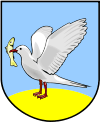Gniew
Gniew (pronounced Gnef [ɡɲef], German: Mewe, Kashubian: Gniéw) is a historic town situated on the left bank of the Vistula River, in the Pomeranian Voivodeship, northern Poland, with 6,870 inhabitants (2016). One of the most oldest towns in Polish Pomerania, Gniew is renowned for its medieval brick gothic Castle, which has become the region's most recognizable monument.
Gniew | |
|---|---|
Gniew Castle, one of the most recognizable landmarks in Pomerania | |
 Flag  Coat of arms | |
 Gniew | |
| Coordinates: 53°50′0″N 18°50′0″E | |
| Country | |
| Voivodeship | Pomeranian |
| County | Tczew |
| Gmina | Gniew |
| Established | 13th century |
| Town rights | 1297 |
| Government | |
| • Mayor | Maria Gurzyńska |
| Area | |
| • Total | 6.75 km2 (2.61 sq mi) |
| Elevation | 47 m (154 ft) |
| Population (2016) | |
| • Total | 6,870 |
| • Density | 1,000/km2 (2,600/sq mi) |
| Time zone | UTC+1 (CET) |
| • Summer (DST) | UTC+2 (CEST) |
| Postal code | 83-140 |
| Area code(s) | +48 58 |
| Car plates | GTC |
| Website | http://www.gniew.pl |
History
The first recorded mentions of Gniew appear in written documents of the first half of the 13th century, which refer to the region as Terra Gymeu (Gmewan, Gimen, Gymen) in 1229, terra Mewe in 1250, and terra Gemewe in 1283,[1] terra Mewa.[2] The name Gniew is of native, Polish origin. The name Wansca (Wońsk) was also used. The German name of Mewe is a Germanized form of the Polish name Gmewe. The town's coat of arms is an example of canting, as it depicts a seagull (German: Möwe), which alludes to the town's Germanized name.
Beginning in the 10th century, the region belonged to the Polan tribe and was part of Gdańsk Pomerania. After the division of Poland by Bolesław III Wrymouth, Gniew fell to the castellany of Starogard Gdański. The land later fell to the Dukes of Świecie and in 1229 Duke Sambor and Swietopelk II of Pomerania granted it to the Cistercian abbey in Oliwa. In the second half of the 13th century, Sambor retook Gniew from the Cistercians and in 1276 bestowed it on the Teutonic Knights. Their claim was formally recognized by Mestwin II of Pomerania in 1282, and the city became the first stronghold of the Teutonic Order on the left riverside of the Vistula. A castle was built as a result of this important strategic location, and in 1297 the Teutonic Knights gave Gniew town privileges.
The city exchanged hands various times between 1410-1466 until it was recognized as part of Poland by the Teutonic Order following the Second Peace of Thorn (1466). Administratively it was part of the Pomeranian Voivodeship in the Polish province of Royal Prussia, later also in the province of Greater Poland. Gniew was the seat of the starosts (local district governors), they resided in the Gniew castle.[3] In 1454 Gniew was temporarily the first seat of the Polish voivodes of Pomerania. In 1626, during the Swedish-Polish War, a battle between the Polish-Lithuanian Commonwealth and Swedish forces was fought in the area of Gniew, resulting in a (formal) victory for the army of King Gustavus Adolphus of Sweden, but battle was unresolved.[4]
.jpg)
In the second half of the 17th century, prior to becoming King of Poland, John III Sobieski served as the starost of Gniew and built the "Marysieńka Palace" for his wife, Queen Marie Casimire.
Gniew was annexed by the Kingdom of Prussia during the Partitions of Poland and became part of the German Empire in 1871. During the Napoleonic Wars, General Jan Henryk Dąbrowski spent four months in Gniew on medical treatment.[5] During the partition period, Gniew was a strong Polish pro-independence centre. Polish organisations were established and operated here, demonstrations were held here, volunteers were secretly recruited for the January Uprising in the Russian Partition.[5] With the defeat of Imperial Germany in World War I, Gniew became part of restored Poland according to the Treaty of Versailles. This date is celebrated in Gniew till today as liberation from Prussian oppression and end of 148 years of attempts to destroy Polish existence.[6]
After the First World War number of ethnic Germans within the town decreased.[7][8] During World War II the castle was used by Nazi Germany as a prison for the ethnically cleansed Polish population of Tczew and the surrounding area.
Main Sights

The most notable landmark of the town is the Ordensburg castle built by the Teutonic Order at the turn of the 14th century, which later served as the seat of the local starosts, as well as Marysienka's Palace, built during the second half of the 17th century. The city also boasts a well preserved medieval old town, with buildings dating from the 15th to 19th century and a Gothic church dating to the 14th century.
Notable people
- Iwan Knorr (1853–1916), German composer and teacher of music
- Grzegorz Bonin (born 1983 in Gniew), Polish footballer, played over 400 games, incl. one for Poland
International relations
Gniew is twinned with:
References
- Kęsikowa, Urszula (1 January 1976). "Nazwy geograficzne Pomorza Gdańskiego z sufiksem -ov-". GTN. Retrieved 26 March 2017 – via Google Books.
- "Terra Gymeu - Google Search". Retrieved 26 March 2017.
- "Gniew w Rzeczypospolitej, Miasto i Gmina Gniew". Retrieved June 18, 2019.
- https://web.archive.org/web/20130406155044/http://www.radoslawsikora.republika.pl/GniewVivatVasa.pdf
- "Gniew pod zaborami, Miasto i Gmina Gniew". Retrieved June 18, 2019.
- "Miasto i Gmina Gniew". Retrieved 26 March 2017.
- Kotowski, Albert S. (1998). Polens Politik gegenüber seiner deutschen Minderheit 1919-1939 (in German). Forschungsstelle Ostmitteleuropa, University of Dortmund. p. 55. ISBN 3-447-03997-3.
- "Miasto i Gmina Gniew". Retrieved 26 March 2017.
